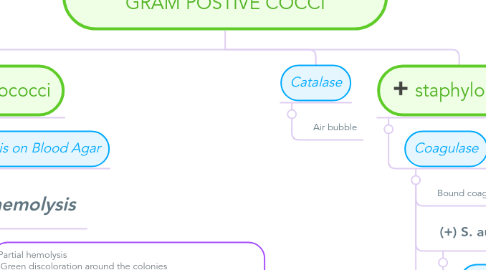
1. Streptococci
1.1. Hemolysis on Blood Agar
1.1.1. a-hemolysis
1.1.1.1. Partial hemolysis Green discoloration around the colonies e.g. non-groupable streptococci (S. pneumoniae & S. viridans)
1.1.1.2. Optochin Test
1.1.1.2.1. inhibition zone ≥14 mm
1.1.1.2.2. (S) S. pneumoniae
1.1.1.2.3. (R) S. viridans
1.1.2. b-hemolysis
1.1.2.1. Complete hemolysis Clear zone of hemolysis around the colonies e.g. Group A & B (S. pyogenes & S. agalactiae)
1.1.2.2. Bacitracin susceptibility Test
1.1.2.2.1. inhibition zone and identification of group A
1.1.2.2.2. (S) S. pyogenes (Group A)
1.1.2.2.3. (R) non group A
1.1.2.2.4. CAMP test
1.1.3. g-hemolysis
1.1.3.1. No lysis e.g. Group D (Enterococcus spp)
1.1.3.2. Growth in 6.5% NaCl broth
1.1.3.2.1. Ability to grow in 40% bile and hydrolyze Esculin
1.1.3.3. Bile Esculin hydrolysis
1.1.3.3.1. – Differentiates Group D streptococci from enterococci
2. Catalase
2.1. Air bubble
3. staphylococci
3.1. Coagulase
3.1.1. Bound coagulase and Free coagulase
3.1.2. (+) S. aureus
3.1.2.1. mannitol fermentation (yellow)
3.1.2.2. DNAase positive (producing colonies surrounded by clear areas due to DNA hydrolysis)
3.1.3. (-) CNS
3.1.3.1. Novobiocin
3.1.3.1.1. inhibition zone ≥ 17 mm
3.1.3.1.2. (+) sensitive S.epidermidis
3.1.3.1.3. (-) resistant S. saprophyticus

